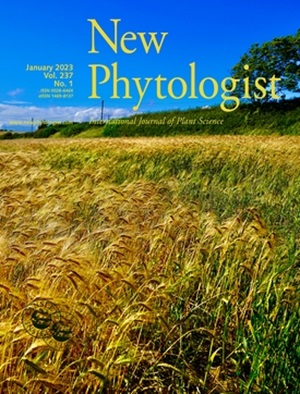FolSas2是尖孢镰刀菌感染过程中早期效应基因表达的调控因子
IF 8.3
1区 生物学
Q1 PLANT SCIENCES
引用次数: 0
摘要
番茄枯萎病(Fusarium oxysporum f. sp. lycopersici, Fol)是一种全球毁灭性的番茄枯萎病,它依靠大量效应菌的分泌来引发侵染,但在植物侵染过程中,这种致病真菌如何精确调控效应基因的表达仍是一个谜。在这里,通过分子和细胞方法,我们发现组蛋白H4K8乙酰转移酶FolSas2是foll早期效应基因表达的转录调节因子。FolSas2在K269上的自乙酰化抑制K335的泛素化,阻止其被26S蛋白酶体降解。在早期感染过程中,foll通过改变自身和FolSir1去乙酰化酶的转录差异来提高FolSas2乙酰化,导致该酶在这一阶段特异性积累。FolSas2随后激活一系列效应基因的表达,因此,foll成功入侵番茄。这些发现揭示了植物真菌入侵过程中通过组蛋白修饰子的自乙酰化调控效应基因表达的机制。本文章由计算机程序翻译,如有差异,请以英文原文为准。
FolSas2 is a regulator of early effector gene expression during Fusarium oxysporum infection
- Fusarium oxysporum f. sp. lycopersici (Fol) that causes a globally devastating wilt disease on tomato relies on the secretion of numerous effectors to mount an infection, but how the pathogenic fungus precisely regulates expression of effector genes during plant invasion remains elusive.
- Here, using molecular and cellular approaches, we show that the histone H4K8 acetyltransferase FolSas2 is a transcriptional regulator of early effector gene expression in Fol.
- Autoacetylation of FolSas2 on K269 represses K335 ubiquitination, preventing its degradation by the 26S proteasome. During the early infection process, Fol elevates FolSas2 acetylation by differentially changing transcription of itself and the FolSir1 deacetylase, leading to specific accumulation of the enzyme at this stage. FolSas2 subsequently activates the expression of an array of effectors genes, and as a consequence, Fol invades tomato successfully.
- These findings reveal a regulatory mechanism of effector gene expression via autoacetylation of a histone modifier during plant fungal invasion.
求助全文
通过发布文献求助,成功后即可免费获取论文全文。
去求助
来源期刊

New Phytologist
生物-植物科学
自引率
5.30%
发文量
728
期刊介绍:
New Phytologist is an international electronic journal published 24 times a year. It is owned by the New Phytologist Foundation, a non-profit-making charitable organization dedicated to promoting plant science. The journal publishes excellent, novel, rigorous, and timely research and scholarship in plant science and its applications. The articles cover topics in five sections: Physiology & Development, Environment, Interaction, Evolution, and Transformative Plant Biotechnology. These sections encompass intracellular processes, global environmental change, and encourage cross-disciplinary approaches. The journal recognizes the use of techniques from molecular and cell biology, functional genomics, modeling, and system-based approaches in plant science. Abstracting and Indexing Information for New Phytologist includes Academic Search, AgBiotech News & Information, Agroforestry Abstracts, Biochemistry & Biophysics Citation Index, Botanical Pesticides, CAB Abstracts®, Environment Index, Global Health, and Plant Breeding Abstracts, and others.
 求助内容:
求助内容: 应助结果提醒方式:
应助结果提醒方式:


